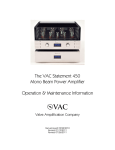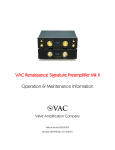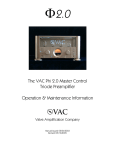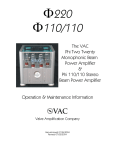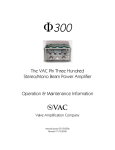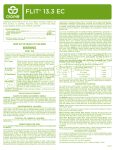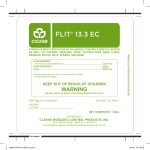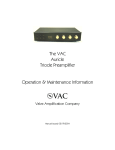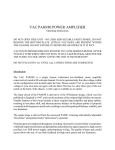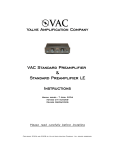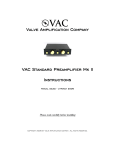Download The VAC Phi Beta Triode Preamplifier Operation & Maintenance
Transcript
F The VAC Phi Beta Triode Preamplifier Operation & Maintenance Information Valve Amplification Company Manual issued 02/15/2008 CAUTION THE PREAMPLIFIER AND POWER SUPPLY CONTAIN POTENTIALLY LETHAL VOLTAGES, AND TUBES THAT BECOME HOT IN USE. NEVER OPERATE THE PREAMPLIFIER OR POWER SUPPLY WITH THE COVERS REMOVED. DO NOT REMOVE THE CHASSIS COVERS EXCEPT TO CHANGE TUBES OR LIGHT BULBS. BEFORE OPENING A CHASSIS TO CHANGE TUBES OR LAMPS, DISCONNECT THE POWER SUPPLY FROM AC POWER AND THE AUDIO CHASSIS FROM ALL OTHER COMPONENTS. ALLOW IT TO SIT TURNED OFF FOR 30 MINUTES BEFORE REMOVING THE COVER. REPLACE COVER AND SECURELY ATTACH BEFORE RECONNECTING AND OPERATING DO NOT OPERATE THE UNITS IF THEY ARE WET. VACUUM TUBES BECOME HOT ENOUGH TO CAUSE SERIOUS BURNS. NEVER TOUCH A TUBE WHEN THE UNIT IS ON. IT MAY TAKE SEVERAL MINUTES FOR THE TUBES TO COOL DOWN AFTER THE UNIT IS SWITCHED OFF. IT IS STRONGLY RECOMMENDED THAT THE TUBE COVERS BE LEFT IN PLACE AT ALL TIMES. THE AMPLIFIER AND POWER SUPPLY ARE HEAVY. IT IS ADVISABLE TO HAVE ASSISTANCE IN UNPACKING, MOVING, AND SETTING UP. BE SURE TO USE PROPER LIFTING TECHNIQUES TO AVOID BACK STRAIN AND INJURY. BE CERTAIN TO INSTALL IT IN A SECURE LOCATION FROM WHICH IT CAN NOT FALL OR TIP OVER. CONTENTS Introduction Installation Inputs (back panel) Outputs & Grounding Switch (back panel) Operation Fuses Front Panel Controls Remote Control Replacement of Tubes Care of Chassis A Word About Tubes In General / Locating a Defective Tube Warranty / Registration Form 1 INTRODUCTION The Phi Beta Preamplifier is the world's finest audio preamplifier and an absolutely unique component. Its unusual topology, premium parts, and flexibility make it a pleasure to hear and operate. The line stage is, in effect, a small Class A1 power amplifier, capable of driving loads as low as a few hundred ohms. This is a stark contrast to normal preamplifiers, which claim a low output impedance but completely collapse when asked to deliver current. The Phi circuit is loafing with a normal load in the 10,000 to 200,000 ohm range, delivering an effortless, musical performance. There is no loop feedback and no coupling capacitors in the line section. All active elements are triode tubes, the purest, most linear amplifying devices yet invented. Output matching is accomplished by way of superb output transformers. As a side benefit, different output grounding configurations are possible, optimizing performance into either balanced or single-ended loads, and allowing ground loops to be broken. The optional phono stage uses triode tubes operating without loop feedback. Gain is moderately high, with a very low noise floor. Low output MC cartridges are accommodated by means of high quality matching transformers, which contribute voltage gain without noise, resulting in detail that emerges from a remarkably dark and neutral background. Remote volume control is implemented via a motorized mechanical device. This provides two major advantages. First, the control is completely intuitive to use. Second, we avoid the sound degradation attendant with VCAs, transistor switches, and switched resistor arrays. Each chassis is fabricated from non-magnetic aluminum. The separate power supply allows e.m.f. fields, switching transients, and mechanical vibration to be isolated from the audio circuits. The Phi Beta Preamplifier is designed not to the latest fad but to substance, for the highest possible sound quality. Time spent familiarizing yourself with this manual will be well rewarded. 2 INSTALLATION 1) Provide adequate ventilation. 2) Do not operate on carpet or any other surface that might block air flow. 3) The chassis will become warm in normal use. 4) Do not allow the chassis to touch any metal parts, such as the frame of an equipment rack. This might create a parallel ground path that could degrade the sound of your system. 5) Input connection is via single ended RCA jacks or XLR jacks (which can be from balanced or unbalanced sources). For the inputs that can accept either XLR or RCA connectors, be sure that the associated switch is set correspondingly. Connect line level inputs (CD, Tuner, Tape, etc.) to the appropriate RCA input jacks on the rear panel. Note: with the exception of Phono (when fitted), all inputs are "line level." 6) Output to the power amplifier can be single-ended on RCA jacks or balanced on XLR jacks, but not both simultaneously. The output mode switch must be set to match the connections used. IMPORTANT: READ THE SECTION ON "OUTPUTS & GROUNDING SWITCH." 7) Output to a recording device (tape recorder, CD recorder, etc.) may be obtained from the “TAPE OUT” jacks. The adjacent switch for “TAPE OUT” must be set to ON. If your system does not have a recorder, this switch should be set to OFF. 8) For optional phono stage only: Connect phono cables to the rear panel MM and/or MC inputs labeled "Phono" (both may be used in the same system, as they are switched by a control on the front panel). Connect the ground wire(s) from the turntable(s) or phono cable(s) to the "Ground" terminal provided on the rear panel. 9) Connect the power cable from the power supply to the preamplifier. Be sure to insert the connector properly, and fully tighten the locking screws. 10) Connect the power supply to the power source indicated on the rear panel, either 100, 120, 220, or 240 volts AC. The voltage is set at the factory. Avoid power conditioners that float the ground pin. ALWAYS connect power cord to component before plugging it into an AC outlet. For best performance, try to route the power cord away from signal cables. 3 11) Pay close attention to power quality, and be aware that different power cords can alter the sound. The power supply’s backlit meters show variation in power line voltage as reflected to the audio circuitry. 12) 12 volt triggers are provided for control of other audio components. 4 INPUTS (back panel) Inputs #1, #2, and Cinema may be either unbalanced or balanced. Three connections are possible: 1) Single ended signal on RCA connector. Set adjacent switch to “RCA.” 2) Balanced signal on XLR connector. Set adjacent switch to “BAL.” 3) Single ended signal on XLR connector. Set switch to “BAL.” Alternatively, you may set the switch to “RCA” if and only if the source is “pin 2 hot.” One pair of RCA jacks accommodate the monitor return from a tape deck. If you do not have a tape deck, these jacks can be used as an additional line level input. If using the tape outputs, the TAPE OUT switch must be set to “ON.” Two phono inputs are provided for "MC" and "MM" cartridges. The ground lead from the turntable should be connected to the binding post located by these jacks. OUTPUTS & GROUNDING SWITCH (back panel) One pair of RCA jacks provide line level output to a tape recorder. The level of signal is not adjusted by the volume control. If using the tape outputs, the TAPE OUT switch must be set to “ON.” Two sets of RCA output jacks are provided as main outputs to power amplifiers. In addition, two pair of XLR jacks can be used to drive a power amplifier. The “OUTPUT MODE” switch must be set accordingly. Only one mode may be used, i.e., you can not mix balanced and single-ended power amplifier connections. 5 OPERATION Turn the "Volume" control fully counterclockwise. Mute is automatically engaged when switching on the unit. Allow the preamplifier to warm up for a minute before you un-mute the unit; failure to wait can cause a transient to be sent through your power amplifier that might cause damage to your loudspeakers. PLEASE READ THE SECTION ON FRONT PANEL CONTROLS BEFORE USING THE PREAMPLIFIER. As with all high fidelity products, the sound characteristic of the VAC changes somewhat as it warms up. Best sound will be achieved after about 15 minutes of operation. Any time that the Phi Preamplifier has not been used for a few weeks the sound may be different. This is also normal for high resolution audio equipment. Optimum sound should return after a few hours of operation, preferably with an audio signal. Note that although your VAC System has been run for 48 hours at the factory, it will continue to "break in" for approximately 150 hours. Also be aware that many components display the need for a new break in period after being transported in unheated cargo aircraft. FUSES The fuse is located behind in a tray above the AC power connector; the fuse carrier contains the fuse being used, as well as a spare. For 220 or 240 volt operation, please use a 1.0 ampere fuse. For 100 or 120 volt operation, the fuse should be 2.0 amperes. Voltage conversions must be accomplished at the factory or via the importer for your country. Please consult the factory for more information. 6 FRONT PANEL CONTROLS Although most of the front panel controls (Volume, Power, Mute) are self explanatory, VAC has outfitted this unit with several advanced features which bear further description: Power: Turns the unit off and on. Mute: Toggles between the "Mute" and "Operate" condition. When muted, the indicator light is illuminated. Tape: This switch selects between the signal coming from the main selector (light out) or the signal connected to the “TAPE IN” jacks (light on). Cinema: This switch selects the source connected to the “CINEMA” input jacks. Volume (switch): This switch allows any input (except Phono) to be level controlled (VAR or variable) by the rotary VOLUME control, or to be produced at a SET (fixed) level. To set this function, hold the toggle switch in the direction of the desired setting for five seconds, until the indicator light changes from blinking to solid illumination. In the VARIABLE mode, the Phi functions as a conventional preamplifier. The SET mode allows the control of volume to be determined entirely by the source component. This is useful when the Phi Beta Preamplifier is being used as an element of a multichannel or home theater system, with the level of all 5.1 channels being set by the player or the decoder. The SET mode may also be used with, for example, a CD player that has its own volume control. In this way, the Phi’s volume control is bypassed. Some audiophiles would consider this to be a “hot rod” mode. Note: The Tape Monitor input takes the same setting as the source input. For example, if the SELECTOR is on input #1 and #1 is set up in a SET mode, when you engage the TAPE monitor it will also be in the SET mode, and the VOLUME control will not change the sound level. Conversely, if input #2 is in the VAR mode, then the TAPE monitor will also be in the VAR mode, and the volume control will function. Therefore, it is suggested that the input be configured to VAR before recording and monitoring is started. 7 Phono: Selects between the MM and MC inputs. Overall phono function is selected with the main Selector switch (phono is one click counterclockwise from “1” or one click clockwise from “6”). PH1 is the MC phono input. It has 64 dB of gain, making it suitable for most low output cartridges. PH2 is the MM input, which provides 44 dB of gain, suitable for use with MM (moving magnet) and many high-output MC (moving coil) cartridges. Optionally, PH2 may be a second MC input. Both PH1 and PH2 may be connected in the same system, so that in essence there are two phono inputs, selectable from the front panel. Selector: This switch selects between IN1 through IN6 and the PHONO inputs. Rotate counterclockwise to move down through the inputs, clockwise to move up through the inputs. Volume: Controls the output level for the PHONO input, and any line input set to the “VAR” LEVEL mode. Note: it is possible that one or both channels may not shut off completely in the fully counter-clockwise position, and that channel balance may skew at whisper levels. Meters: Indicate the operating voltages within the unit. This will vary somewhat due to fluctuations in power line voltage. 8 REMOTE CONTROL The remote control allows for wireless adjustment of POWER, SELECTOR, TAPE MONITOR, CINEMA, MUTE, and VOLUME. The remote wand is powered by two "AAA" batteries. These should be of the alkaline type. You will need to install them in the wand before using the remote. Since batteries can leak, they should be removed from the wand if it is not going to be used for an extended period of time. Be sure to observe the polarity diagram inside th battery compartment. 9 REPLACEMENT OF LOW LEVEL TUBES Phono tubes are type 12AX7/ECC83; you may wish to use low noise tested tubes. Line stage tubes are type 8416, no substitute types are acceptable. We strongly recommend that you use only tubes specifically selected and tested by VAC for this application. Before replacing tubes, all power must be turned off. Allow 15 minutes for the tubes to cool down and voltages to discharge before removing the top cover. The voltages inside the unit may be lethal in normal operation. NEVER OPERATE THE PREAMPLIFIER WITHOUT THE COVER INSTALLED. Install new tubes firmly in their sockets, noting the location of holes in the socket and pins of the tubes, taking care to make sure that pin pattern corresponds to holes in tube socket. Replace the cover before reconnecting and operating the preamplifier. In the event that trouble is encountered, check all signal, speaker and power connections. If the problem persists, follow all safety precautions stated earlier in this section, and check that all tubes are correctly seated in their sockets. If possible, try another tube. If the problem persists, please consult your VAC dealer or contact the factory directly. Tubes are like the tires on a car; they will eventually need replacement. Murphy's Law states that a tube will probably fail right at the start of a long holiday weekend. Therefore, many audiophiles keep a spare tube of each type on hand, just in case! VAC can test tubes for concerned customers. 10 TIPS & ADVICE SECTION A Word About Tubes in General It is true that each brand of tube sounds different in a particular high resolution circuit. This is because no two manufacturers make a tube type in quite the same way, and the central tendencies of the performance parameters will differ slightly with each maker. To emphasize the point, examine the plate structure of any two 6SN7 from different manufacturers will probably find that they may not even the same shape and size. (Be careful here, as often a tube is made by a firm other than indicated on its label. In the heyday of tubes it was common to crossbrand between major labels, such as GE and RCA. Today many labels do not manufacture their tubes at all, including Gold Aero and RAM.) This sonic variability may at first seem a liability, but further thought will reveal that it is an advantage, just like the ability to adjust VTA on a tone arm. The owner of a tube amplifier can select those tubes which sound like the real thing in his/her specific system. Of course, if the manufacturer you prefer is rare you may want to purchase a few spare tubes for the future. How long should tubes last? It has long been known in professional circles (and probably now forgotten) that a tube such as the 12AX7 will display better performance characteristics after two years of continual operation than when it was new. In normal use it is not unusual for a low level tube to last 5 years or longer. Output tubes are another story, as they are continually providing significant amounts of current. Here the sound is your best guide. Certainly a tube should be replaced when its emission is significantly down or its transconductance is substantially out of specification. In normal use, output tubes will last at least 2 years and perhaps more than 5 years. In the event of unusual noise in one channel, or a loss of sound in one channel, a bad tube may be located easily. If the problem is audible in the line stage, exchange the two 8416 tubes; if the problem changes channels then you have found the bad tube. If the problem is only audible on phono, swap the rear pair, then the middle pair, then the front pair, each time listening to see if the symptom follows the tube. VAC can test tubes for concerned customers. 11 CARE OF CHASSIS VAC chassis are made from aluminum for superior electromagnetic performance. The main chassis is finished in a durable black powder coat paint, while the fascias are hand rubbed acrylic lacquer. The lacquer should be treated in much the same fashion as a high quality automotive finish. Never apply any dampness or cleaning product to a unit that is plugged in. Do not get cleaning solutions onto or into the tube sockets. 12 WARRANTY Your equipment is warranted for a period of thirty (30) days from the date of purchase. In addition, if the registration form is received by VAC along with a copy of your sales receipt from an authorized VAC dealer within this thirty days, a service contract will be extended to cover your equipment for two (2) years (tubes excepted). This warranty applies only to units sold in the United States of America through authorized VAC dealers and operated within the United States by the original purchaser. It covers factory service and, within the continental U.S., standard return shipping. For warranty information outside of the U.S. contact the importer of VAC equipment for your country. Units sold outside of the U.S. should still be registered with VAC. It is responsibility of the dealer and customer to determine suitability of this unit for a given application. Your questions and comments are always welcome. Contact: Valve Amplification Company 1911 East Avenue North Sarasota, FL 34234 Telephone (941) 952-9695 [email protected] Fax (941) 952-9691 _____________________________Detach and mail to the address above as soon as possible.____________________________ Phi Beta Preamplifier Registration Form Name ________________________________________________________________________ Address ________________________________________________________________________ ________________________________________________________________________ Telephone _______/_______-_____________ e-mail __________________________________ Dealer name ________________________________ City ________________________________ Salesperson ___________________ Purchase date ____________ Serial Number ________________ How did you first learn of VAC products? ____________________________________________________ What other brands/models did you consider? _________________________________________________ _____________________________________________________________________________________ What made you decide on the VAC? _______________________________________________________ _____________________________________________________________________________________ What else would you like us to know? _______________________________________________________ _____________________________________________________________________________________ _____________________________________________________________________________________ Optional: What magazines do you read regularly?________________________________________________________ What are your hobbies (besides filling in warranty cards)? _______________________________________ What are your favorite types of music? ______________________________________________________ _____________________________________________________________________________________ On what format? (CD, LP, DVD, SACD, MP3, etc.) ______________________________________________ 13














